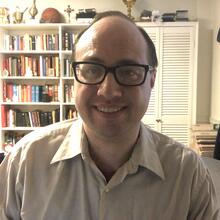Father Dennis Hamm is a Jesuit priest, spiritual director and professor emeritus of theology at Creighton University in Omaha, Neb. An expert on the Ignatian examen and a specialist in the Gospel of Luke, Father Hamm has authored four books and more than a hundred articles on topics ranging from Ignatian spirituality to the New Testament and its implications for Jewish-Christian relations. From 1996 to 1999, he wrote the weekly Word column for America, and his most recent book is Building Our House on Rock: The Sermon on the Mount as Jesus’ Vision for Our Lives, as Told by Matthew and Luke (Word Among Us Press).
I recently interviewed Father Hamm by email about the Ignatian examen prayer. This text has been condensed and edited.
What is an “Ignatian examen of conscience” and why do people pray it?
An Ignatian examen of conscience is any effort a person makes to pray using the method that St. Ignatius of Loyola prescribes in his Spiritual Exercises at number 43, “A Method for Making the General Examination of Conscience.” It contains five points: (1) to give thanks to God for the benefits I have received; (2) to ask for grace to know my sins and rid myself of them; (3) to ask an account of my soul from the hour of rising to the present examen, hour by hour or period by period; first as to thought, then words, then deeds; (4) to ask pardon of God our Lord for my faults, and (5) to resolve, with his grace, to amend them. Close with an Our Father.
How does an Ignatian examen differ from the examination of conscience a Catholic would make before going to confession?
The description in my first answer is clearly the traditional examination of conscience in preparation for confession (the Sacrament of Reconciliation) that many of us grew up with. But notice that for Ignatius this inventory of one’s faults and sins is done in the context of prayer from start to finish—prayer of thanksgiving, prayer for self-knowledge, petition for pardon, prayer to do better, and finally the Lord’s Prayer itself.
Along with the special communication of Scripture, God reaches us through the experience of a given day.
What has developed in the practice of the Ignatian examen during the past 40 years is that some people have taken a cue from the fact that in French and Spanish the word for conscience also can mean consciousness. In French the word is conscience, and in Spanish conciencia. Whether or not Ignatius meant it that way, the fact that the word for conscience can also mean consciousness has encouraged people to pray about the remembered experience of the day in all of its dimensions—including, of course, one’s faults and sins, which tend to present themselves whether we are looking for them or not.
Why do people pray it?
I suppose the motives vary for each person. My own motives include the conviction that, along with the special communication of Scripture, God also reaches me through the experience of a given day. So I am glad to recall and relish the memories of the past 24 hours. There is always something to pray about—whether the experience is positive or negative. The prayer confronts me with the reality of my life and gives me something to speak with God about.
What does “Ignatian” mean to you?
Whether Ignatian is applied to prayer, spirituality, education or whatever, certain characteristics of Ignatius and his Spiritual Exercises are implied—things like taking experience seriously, expecting God to speak to us through our experience, contemplation that leads to action, prudential adjustment to circumstances, humility before God and fellow creatures, and discernment.
You once wrote a popular article on the Ignatian examen for America called “Rummaging for God: Praying Backwards through Your Day” (5/14/94). What did you mean by that title?
I was trying to evoke the image of sticking your hand into a chest of drawers and feeling around for something you know is in there someplace. It is a metaphor for looking through “the remains of the day” to discover what God might be saying through one’s experience. “Praying Backwards through Your Day” is simply a subtitle putting the title into other words. It is incomplete, of course, because part of what I recommend is taking time also to “pray forward,” anticipating what one expects or plans about the future and praying about that.
In the past two decades since writing this article, how have your thoughts on the examen evolved?
One thing I have learned is that the practice has sometimes made me more aware of my inner responses as they are happening, and not only later, in retrospect.
Early morning, right upon waking, can be a good time to pray about yesterday.
Another thing is that early morning, right upon waking, can be a good time to pray about yesterday. It is a great time, as well, to pray about the day to come.
My point of using remembered feelings as cues to key moments of the past day (or regarding things I anticipate about the immediate future) has meant a lot to people. Remembered emotions or emotions evoked in anticipation of predictable or planned future events are great starting points for prayer.
The Constitutions of the Society of Jesus encourage every Jesuit to pray the Ignatian examen twice a day. What have you learned from your own practice of the examen since you entered the Society?
I appreciate the wisdom of Ignatius advising fellow Jesuits that, even when one is so busy that the demands of life encroach on one’s routine time for daily meditation, one ought never to let go of some prayer of examen. It ensures that even the over-active person can retain at least a minimum of contemplation. Let go of examen prayer, and you can lose touch with how your busy-ness serves God, and you can get manipulated by unexamined emotions.
What’s the format for an Ignatian examen and how long does it take to pray?
Ignatius’ format is number 43 in his Exercises. My own format improvises on Ignatius’ just a bit, and goes like this:
- Prayer for light. This is not daydreaming about the past, but a search for graced understanding;
- Thanksgiving. Go through your memory of the past 24 hours looking for things that evoke gratitude to God;
- Feelings. Revisit the day again, alert to memories that carry distinct feelings, positive or negative, for these are where the action was, and therefore good starting places for prayer;
- Focus. Pick just one of those stronger memories, and speak to the Lord as you are moved;
- Future. Face the future, to the extent it is predictable, using your appointment book as a prompt if that helps, and pray about anything that stirs some emotional response, positive or negative.
How long? Give it at least ten minutes, but after that, as long as you have time for.
What’s the purpose or goal of the Ignatian examen?
Finding real things to pray about, growth in self-knowledge and awareness of other persons and fellow creatures. I think Zen practitioners call this mindfulness.
How might the Ignatian examen continue to be a helpful form of prayer for people today?
Joseph Tetlow, S.J., calls the examen “the most post-modern prayer.” I guess he uses that description because, in this historical moment of conflicting worldviews, change and crises, we have a greater need than ever to process our inner and outer experience in conscious contact with God. What worked in the expansive 16th century still works in the globalizing, greedy and violent 21st.
Any final thoughts?
Even if you are tired, the examen is worth doing. If you fall asleep during the thanksgiving part, you have prayed the most fundamental prayer of all.










I have read Timothy Gallagher's An Ignatian Introduction to Prayer. When you mentioned "Ignatius’ format is number 43 in his Exercises," I looked in Gallagher's book and found that in his book the exercises go to only 40. I didn't know there were more than 40. How many are there? Should I look to another source, or could you please recommend one?
Father Hamm is referring to the numbering of sections (usually about a paragraph each) in the Spiritual Exercises -- there are well over 300 of them. The examen is #43. This is the numbering of St. Ignatius. I'm not sure what Timothy Gallagher is talking about, but he may have his own system of numbering the contents of the Exercises. Hope that's helpful. -Fr. Sean
Wow, I didn't know there are over 300! Please pardon my ignorance . . . I am new to this and still learning, but I do feel that the examen is the way for me to go. This is very helpful. Thank you, Father Sean.
No need to apologize, it was a good and honest question! I'm glad to hear you are taking ownership of your spiritual life and seeking out helpful tools. Godspeed on your prayers!
Bless you, Father Sean!